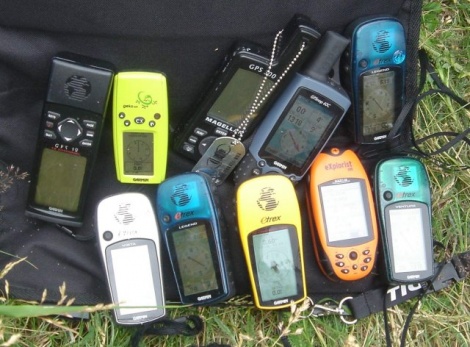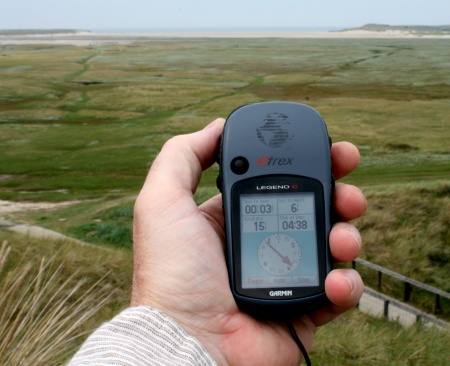If you wish to contribute or participate in the discussions about articles you are invited to contact the Editor
Handheld Outdoor Receivers
| Applications | |
|---|---|
| Title | Handheld Outdoor Receivers |
| Author(s) | Rui Barradas Pereira. |
| Level | Basic |
| Year of Publication | 2011 |
The Handheld Outdoor Receivers are devices conceived for pedestrian navigation, usually in non urban outdoor environments. The handheld GNSS units are self-contained devices which can vary somewhat in size. The smallest ones are about the size of small cell phones. The largest ones are the size of a typical television remote control.[1]
These portable devices are used mostly for hiking and hiking-related activities such as hunting and geocaching. The rural environments where the equipment is typically used, are areas where the surrounding vegetation and orography often block GNSS satellite signals. In environments where there is a clear line of sight to the satellites, GNSS technology is able to provide location with good accuracy and continuity of service.
Product Description
In contrast with road navigation, the outdoor pedestrian movements usully take place in rural environments. Trees and canyons can cause satellite shadow and limit the environments where high-accuracy GNSS data collection can be performed.
In terms of equipments, the Handheld Outdoor Receivers usually have replaceable batteries that can run for several hours, making them suitable for activities far from an electric power source. The cases are rugged and some are also water resistant.
The handheld units screens are commonly small and the early handheld devices did not displayed maps or color, in order to preserve power. Nowadays, handheld outdoor receivers can be found with large sunlight displays, camera, powerful processors, field-swappable battery, compass and pre-installed embedded software able to show interactive maps, points of interest (or waypoints), route information and step-by-step routing directions. Many handheld receivers fully support WAAS and EGNOS.
These products are considered as non-critical products, although they can be used on emergency situations, for instance in isolated areas, where the ability of GNSS to provide a precise position can enhance the chances of rescue when hikers are disabled or lost. This procedure requires a mean of communication with the rescue first responders.
The accuracy required by these applications is low. The current accuracy provided by civilian GPS is enough for these applications. Availability, however, can be reduced by heavy foliage and deep canyons in this type of environment.
Waypoints
The most skillful feature of a handheld GNSS receiver is the Waypoint which is a physical location determined by GNSS on a handheld unit because they let the user know where he actually is located, where he had been, and where he want to go. Capturing user position as a waypoint while somewhere navigating in the big outdoors, is where the waypoint concept is most useful.[2]
The handheld receivers give the user the possibility to input and save many waypoints right on the device during the hiking activities, saving them as a Track. The waypoints can also be uploaded onto the device through external computers or PDA's.
Waypoint Navigation is the concept of capturing users position as a waypoint. The reason for it, is to allow a route to be mapped out using a series of waypoints so the user can navigate from one to the next and so on, like following a trail of virtual breadcrumbs.[2]
In that way, the user know exactly how to get back, due to the Track Log Recording, Return Back, Compass and Altimeter features, which the concepts are detailed in here.
The waypoint concept can also support other type of task such as Photography Geocoding, geocaching, or for instance input a waypoint for a specific geographic feature found during hiking activities.
Product Characterization
Typically the handheld outdoor receivers don't have external attachments. Although, some receivers models can run on external power, (e.g., from a car), connect to an optional external antenna through a jack or connect to a laptop or PDA for expanded uses.[1]
From a technical perspective Handheld Outdoor Receivers were one of the most simple and revolutionary navigation devices. In practical terms, the receiver simply points a straight line towards the next waypoint in the track (loaded or recorded by the user). At the time of product breakthrough, no maps were required and the display was a simple monochromatic screen to save battery. Nowadays the user interfaces features can vary substantially, from simplistic to powerful user interfaces, but usually the screens are able to show satellite constellation, maps, electronic compass, bearing or heading screen, coordinates, tracks with details, speedometer and odometer.
Some handheld outdoor receivers products are conceived to be used in golf activities, providing a set of features such as field information, distances, obstacles and even the registry of all strokes, including distance and power. These devices give to the players the possibility to get real time contextualized information and also to keep a complete database of performances linked with the golf courses.[3]
Another branch of handheld devices, the Marine Handheld receivers, are design for maritime navigation. Those are are waterproof, rugged devices with floating capability and screens conceived to be visible in harsh conditions and direct sunlight, displaying the accurate position, speed, bearing and aids to navigation buoys, among other informations.[4]
Product Examples
Handheld outdoor receivers that fit in this category are[5]:
- Garmin on the trail products
- Lowrance outdoors products
- Magellan outdoors products
- Bushnell GPS products
- DeLorme rugged products
Some of these brands also own lines of golf and marine handheld products.
Notes


